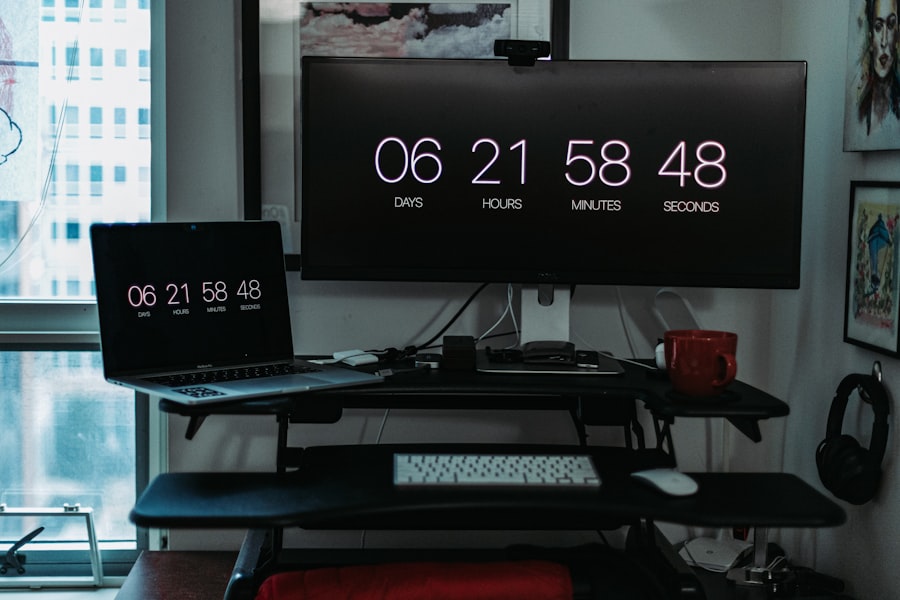In today’s fast-paced world, it’s easy to become overwhelmed by the sheer volume of information and distractions that vie for your attention. You may find yourself scrolling endlessly through social media feeds or getting lost in a sea of notifications, all while your to-do list grows longer. Recognizing that you have a problem with managing your time and focus is the first step toward regaining control.
It’s essential to take a moment to reflect on how these distractions affect your productivity and overall well-being.
Do you struggle to concentrate on important projects?
Acknowledging these feelings is crucial for initiating change. Once you’ve identified the problem, it’s time to dig deeper. Consider the specific triggers that lead you to lose focus.
Is it the constant ping of your phone? The allure of binge-watching your favorite series? By pinpointing these distractions, you can begin to formulate a plan to combat them.
Understanding the root causes of your lack of focus will empower you to take actionable steps toward improvement. Remember, recognizing the problem is not just about admitting defeat; it’s about taking the first courageous step toward a more productive and fulfilling life.
Key Takeaways
- Recognize the problem of excessive screen time and its impact on mental and physical health
- Set boundaries by establishing specific time limits for screen use and sticking to them
- Schedule regular breaks to rest your eyes and reduce the risk of digital eye strain
- Find alternative activities to replace screen time, such as reading, exercising, or spending time outdoors
- Use technology, such as screen time tracking apps, to limit and monitor your screen time and stay accountable
Set Boundaries
Setting boundaries is a vital component of reclaiming your time and focus. You need to establish clear limits on how much time you spend on various activities, particularly those that tend to distract you. For instance, you might decide to allocate specific hours for checking emails or social media, rather than allowing these activities to bleed into your entire day.
By creating these boundaries, you can protect your time and ensure that you dedicate sufficient attention to your most important tasks. Moreover, it’s essential to communicate these boundaries to those around you. Let your friends, family, and colleagues know when you are unavailable for distractions.
This not only helps them respect your time but also reinforces your commitment to staying focused. You might even consider using visual cues, such as a “do not disturb” sign during work hours, to signal that you are in a focused state. Setting boundaries is not just about saying “no” to others; it’s also about saying “yes” to yourself and your goals.
Schedule Breaks
Incorporating regular breaks into your schedule is crucial for maintaining productivity and focus. You may think that working non-stop will help you accomplish more, but in reality, this approach can lead to burnout and decreased efficiency. By scheduling short breaks throughout your day, you give your mind a chance to recharge and refocus.
Consider using techniques like the Pomodoro Technique, where you work for 25 minutes and then take a 5-minute break. This method can help you maintain high levels of concentration while preventing fatigue. During these breaks, it’s important to engage in activities that truly refresh you.
Instead of mindlessly scrolling through your phone, step outside for some fresh air or do a few stretches. These activities can help clear your mind and prepare you for the next work session. Remember, breaks are not a waste of time; they are an investment in your productivity.
By allowing yourself these moments of rest, you’ll find that you return to your tasks with renewed energy and focus.
Find Alternative Activities
| Activity | Benefits | Cost |
|---|---|---|
| Hiking | Physical exercise, connection with nature | Free |
| Yoga | Stress relief, flexibility, strength | Varies |
| Reading | Mental stimulation, relaxation | Cost of books |
| Cooking | Creative expression, healthier meals | Cost of ingredients |
Finding alternative activities can be a game-changer in your quest for better focus and productivity. Instead of defaulting to screen time or other distractions during your downtime, explore hobbies or interests that engage your mind and body in different ways. Whether it’s reading a book, practicing a musical instrument, or engaging in a creative project, these activities can provide a fulfilling break from screens while stimulating your brain in positive ways.
Additionally, consider joining clubs or groups that align with your interests. Engaging with others who share similar passions can provide motivation and accountability while also offering a refreshing change from digital distractions. By immersing yourself in alternative activities, you not only enhance your skills but also create a more balanced lifestyle that prioritizes personal growth over mindless consumption.
Use Technology to Limit Screen Time
While technology can often be a source of distraction, it can also be harnessed to help you limit screen time effectively. Numerous apps and tools are designed specifically for this purpose, allowing you to track and manage your usage across various platforms. For instance, setting daily limits on social media apps can help curb excessive scrolling and encourage more mindful engagement with technology.
Moreover, consider utilizing features on your devices that promote focus. Many smartphones have “Do Not Disturb” modes or screen time tracking options that can help you stay accountable. By leveraging these technological tools, you can create an environment that supports your goals rather than hinders them.
Remember, technology should serve as an ally in your journey toward better focus and productivity.
Create a Designated Workspace

Creating a designated workspace is essential for fostering an environment conducive to concentration and productivity. Whether you work from home or in an office setting, having a specific area dedicated solely to work can help signal to your brain that it’s time to focus. This space should be organized and free from distractions, allowing you to immerse yourself fully in your tasks.
Consider personalizing your workspace with items that inspire you or promote relaxation, such as plants or artwork. Additionally, ensure that your workspace is ergonomically designed to support comfort during long hours of work. By establishing this physical boundary between work and leisure, you’ll find it easier to enter a focused mindset when it’s time to tackle your responsibilities.
Prioritize Tasks
Prioritizing tasks is a fundamental skill that can significantly enhance your productivity and focus. Start by creating a list of all the tasks you need to accomplish, then categorize them based on urgency and importance. This method allows you to identify which tasks require immediate attention and which can be scheduled for later.
By focusing on high-priority items first, you’ll make meaningful progress toward your goals while minimizing feelings of overwhelm. Additionally, consider breaking larger tasks into smaller, manageable steps. This approach not only makes daunting projects feel more achievable but also provides a sense of accomplishment as you complete each step.
Remember, prioritization is not just about getting things done; it’s about ensuring that you’re working on what truly matters in alignment with your long-term objectives.
Practice Mindfulness
Practicing mindfulness is an invaluable tool for enhancing focus and reducing stress in your daily life. Mindfulness involves being fully present in the moment and aware of your thoughts and feelings without judgment. By incorporating mindfulness techniques into your routine—such as meditation or deep breathing exercises—you can cultivate greater awareness of distractions and develop the ability to redirect your attention when needed.
Moreover, mindfulness can help improve your overall well-being by reducing anxiety and promoting emotional resilience. When faced with overwhelming tasks or distractions, taking a few moments to center yourself through mindfulness practices can provide clarity and calmness. As you become more attuned to your thoughts and feelings, you’ll find it easier to maintain focus on the tasks at hand.
Get Regular Exercise
Regular exercise is not only beneficial for physical health but also plays a crucial role in enhancing mental clarity and focus. Engaging in physical activity releases endorphins—natural mood lifters—that can help reduce stress and improve cognitive function. Whether it’s going for a brisk walk, hitting the gym, or practicing yoga, finding an exercise routine that works for you can significantly impact your ability to concentrate.
Incorporating movement into your daily routine doesn’t have to be time-consuming; even short bursts of activity can make a difference. Consider taking walking breaks during work hours or opting for active forms of transportation whenever possible. By prioritizing regular exercise, you’ll not only boost your physical health but also create a positive feedback loop that enhances your mental focus.
Seek Accountability
Seeking accountability is an effective strategy for maintaining focus and achieving your goals. Sharing your objectives with someone else—whether it’s a friend, family member, or colleague—can provide the motivation needed to stay on track. When others are aware of what you’re working toward, they can offer support and encouragement while also holding you accountable for your progress.
Consider forming an accountability group where members share their goals and check in regularly on each other’s progress. This collaborative approach fosters a sense of community while reinforcing commitment to personal growth. Remember, accountability is not about judgment; it’s about creating an environment where everyone feels empowered to succeed.
Monitor Progress
Monitoring progress is essential for understanding what strategies work best for you in enhancing focus and productivity. Regularly reviewing your achievements allows you to celebrate small victories while also identifying areas for improvement. Consider keeping a journal or using productivity apps to track completed tasks and reflect on what methods have been most effective.
As you monitor your progress over time, you’ll gain valuable insights into patterns of behavior that either support or hinder your focus. This self-awareness will enable you to make informed adjustments to your routines and strategies as needed. Remember, progress is not always linear; it’s about continuous growth and learning from both successes and setbacks.
In conclusion, enhancing focus and productivity requires a multifaceted approach that involves recognizing problems, setting boundaries, scheduling breaks, finding alternative activities, utilizing technology wisely, creating designated workspaces, prioritizing tasks, practicing mindfulness, exercising regularly, seeking accountability, and monitoring progress. By implementing these strategies into your daily life, you’ll cultivate an environment that supports sustained focus and empowers you to achieve your goals effectively.
Reducing screen time effectively is a growing concern for many individuals seeking to improve their mental and physical well-being. One approach to tackling this issue is by setting specific goals and creating a structured plan to gradually decrease the amount of time spent on screens. Additionally, incorporating alternative activities such as outdoor exercise, reading, or engaging in hobbies can help fill the void left by reduced screen usage. For more insights and strategies on managing screen time, you can explore this related article on the topic by visiting




